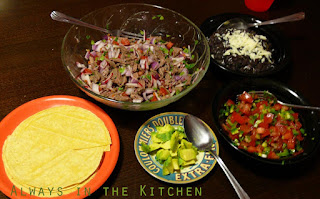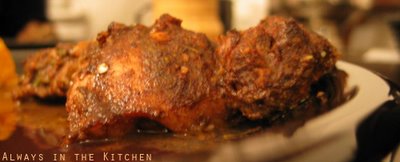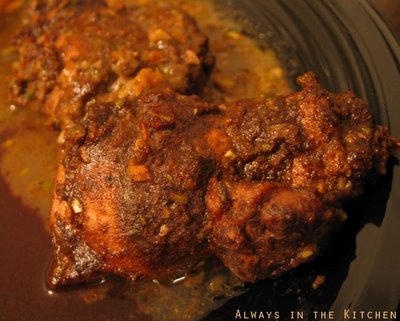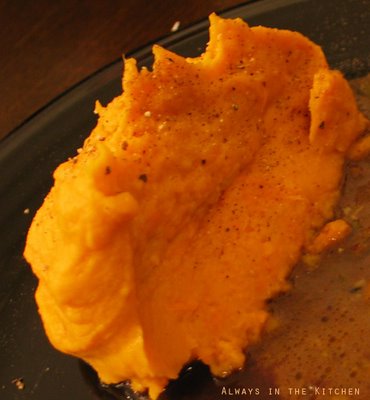
I love Cajun food, which probably comes as no surprise to those of you who know how often I use chiles (and how many, and how hot) in my cooking. That said, there is a wealth of Cajun and Creole dishes that are not hot at all. They are often intensely flavourful without necessarily using loads of chile peppers.
This dish is one of those. The combination of a caramel-coloured roux, smoked duck breast, and artichoke hearts, along with the Cajun trinity of onion, celery, and green bell pepper and typical Cajun herbs and spices makes this Étouffée recipe decadent, richly flavoured, and incredibly satisfying, and is a unique dish in its own right rather than simply replacing seafood with duck in a Shrimp or Crawfish Étouffée. It does have the tiniest bit of cayenne in it, and you could add a drop or two of Tabasco sauce if you insist, but this recipe doesn't even remotely qualify as spicy.
Do not mess around when you are making your roux. It takes a bit of time, and patience, and stirring - generally around 25 minutes of stirring, but it's easy to do and your patience will be rewarded. Make sure you have completed all of your mise en place before you begin the roux. You can cook the rice separately during the simmering stage, which only requires intermittent stirring.
If you do not have access to duck fat to make your roux, use lard. If you cannot source duck stock, a strong brown poultry stock (such as roasted-bone chicken stock) will do, but do note that without duck fat and duck stock in this dish, you will be reducing the luxurious duck flavour significantly. If you've never made roux before, here are some links you might want to check out: Making Roux Step by Step (Allrecipes), and Master the Art of Making Roux (The Daily South). Making a roux is not difficult, but it must be done correctly -- no shortcuts or cowboy moves until you've mastered the basics -- at which time you'll understand why cowboy moves simply shouldn't be applied to roux.
Smoked Duck Étouffée with Artichokes
Adapted from Cajun-Creole Cooking by Terry Thompson-Anderson
Serves 4
Roux
1/2 cup duck fat
1/2 cup flour
Étouffée
1 large yellow onion, diced
1 medium green bell pepper, diced
1 stalk celery, diced
4 large garlic cloves, minced/crushed
600 grams smoked duck breast, diced (largish)
1/4 teaspoon ground cayenne
1/2 teaspoon dried thyme
1/3 teaspoon dried marjoram
1/4 teaspoon dried sage
1/4 teaspoon ground black pepper
dash Tabasco sauce (optional)
1 cup duck stock (room temperature)
3-4 canned artichoke hearts, cut into sixths
2 green onions
handful flat-leaf parsley, chopped
Before you begin, prepare all ingredients so that they are ready to add to the dish. If your duck breast is skin-on, remove the skin and set aside for another dish - perhaps turn it into cracklings to garnish a pasta or an omelette or risotto, or tuck it into the freezer until you know what you want to do with smoked duck skin. Measure out your spices (they can all go into a single mise dish).
In a large Dutch oven, prepare your roux by melting the duck fat over high heat and add all of the flour at once (you can use all-purpose flour or cake flour). Whisk like mad for about a minute, to make sure you don't get any lumps. Then reduce the heat, change your whisk to a spatula, and stir over medium-low heat until it is all smooth and gently bubbling. Continue to stir relentlessly, regularly scraping the entire surface of the bottom of the pot, for about 25 - 35 minutes, or until the roux passes "peanut butter" (light brown) colour and moves on to "caramel" (medium-brown). The darker the roux, the easier it is to burn it, so be increasingly vigilant as you go along. Once the roux begins to darken, the process accelerates: you need to pay attention.
As soon as the roux reaches the right colour, add your onion, bell pepper, and celery (the "Cajun trinity") and the garlic, and cook, stirring frequently, for about 10 minutes, or until they have started to soften. You don't need to turn the heat up - it's plenty hot already.
Add the spices (note there is no added salt in the recipe - there's quite enough from the smoked duck and the duck stock). Stir the spices through and allow to cook for a couple of minutes before adding the diced duck breast. If you are adding Tabasco sauce, add it now.
Add the duck breast, and stir until it is thoroughly coated with the roux.
Pour in the duck stock in a steady stream, stirring constantly, until it is all integrated. Reduce the heat to the lowest setting, cover, and let simmer for 30 minutes, stirring occasionally. At this time, you can put your rice on to cook. We've used parboiled rice here, but long grain white or brown rice would also be fine.
At the end of the simmering time, add the artichoke heart pieces, the green onions, and the parsley, and cook for a further 5 or 10 minutes. Taste the Étouffée and add salt if needed (you probably won't need any, but it's good to check). When the artichoke heart pieces are heated through, you're ready to serve.
To serve, place about 3/4 cup rice in the middle of individual serving bowls, and spoon the Étouffée in around the rice. I like to use a round measuring cup (lightly buttered) to shape the rice --just pack the rice into the cup and turn it over into the middle of each bowl-- but it's certainly not necessary.


















